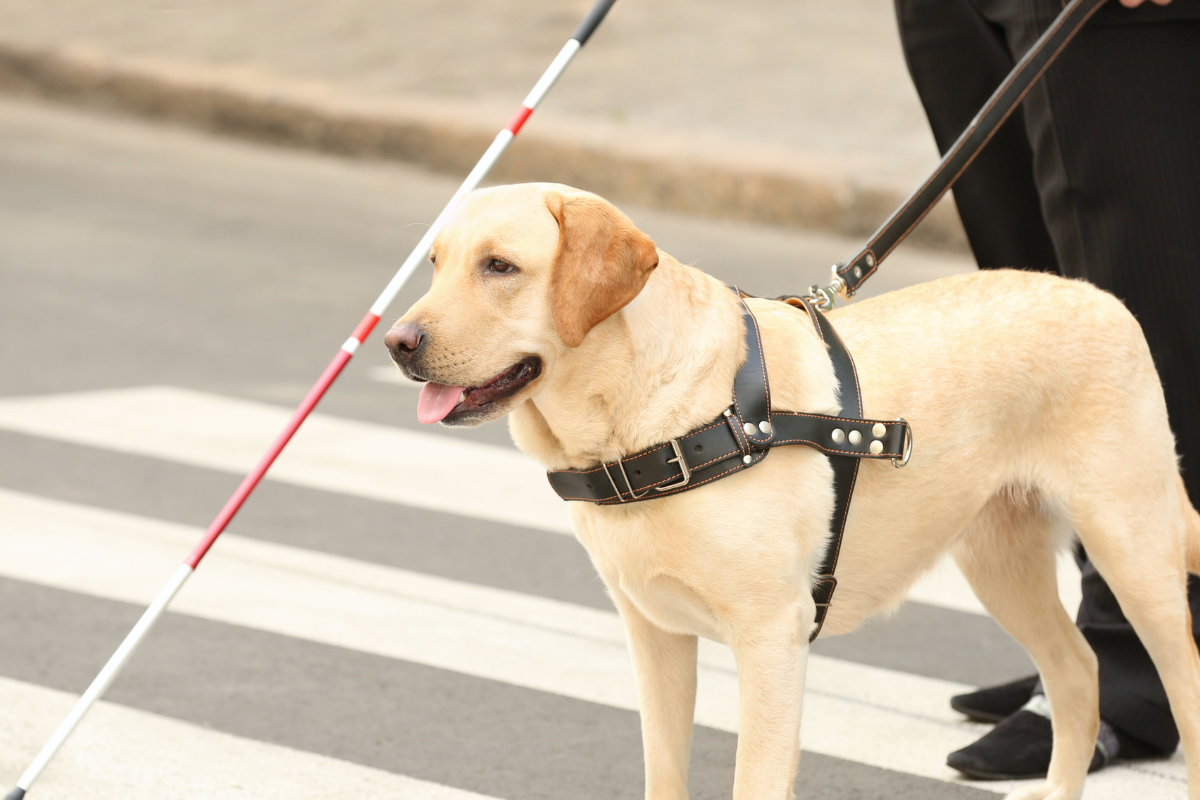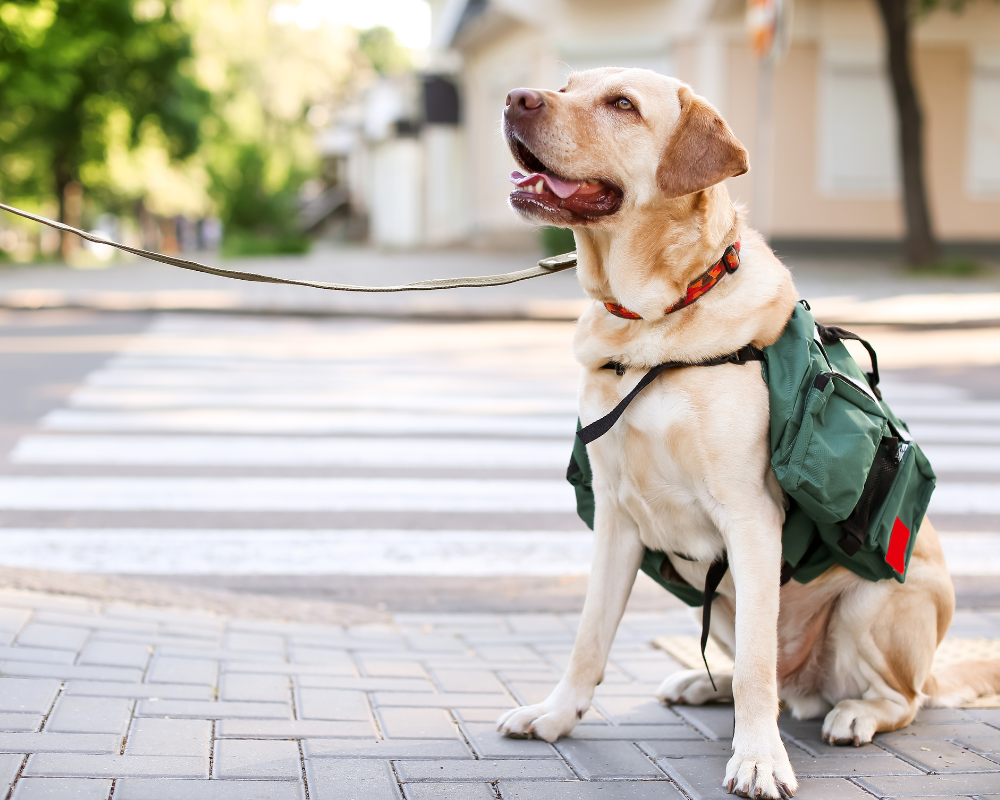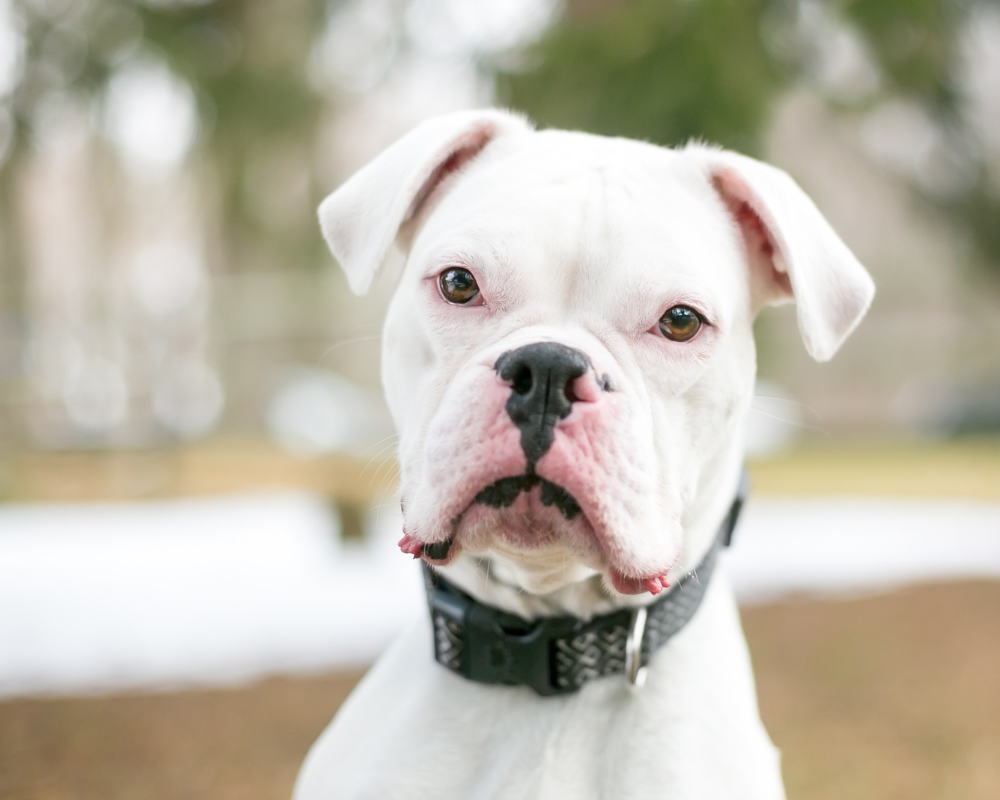Helping a Blind and Deaf Dog: Tips and Advice
Helping a Blind and Deaf Dog: Tips and Advice

Vet Reviewed

By: Sarah Hodgson
February 14, 2024
Table of Contents
Many people are unaware of the challenges that come with caring for a dog that is blind and deaf. It can be a daunting task to help a pet that cannot see or hear, but with patience and understanding, it is possible to provide a good quality of life for the dog. In this article, we will discuss some tips and strategies for helping a dog that is blind and deaf.
Let's dive in!

Understanding Blindness and Deafness in Dogs
Dogs rely heavily on their senses to navigate their surroundings and interact with the world around them. When a dog loses one or more of their senses, it can be a challenging experience for both the dog and their owner. Blindness and deafness are two of the most common sensory impairments in dogs.
Blindness in Dogs
Blindness in dogs can be caused by a variety of factors, including genetics, trauma, infections, and age-related degeneration. Some breeds are more prone to developing blindness, such as the Australian Shepherd, Cocker Spaniel, and Siberian Husky.
Signs of blindness in dogs include bumping into objects, reluctance to move or explore new areas, and changes in behavior or temperament. It's important to note that dogs can adapt to blindness over time, but it may take some patience and training from their owner.
Deafness in Dogs
Deafness in dogs can also be caused by a range of factors, including genetics, infections, and age-related degeneration. Breeds that are more prone to developing deafness include the Dalmatian, Australian Cattle Dog, and Boxer.
Signs of deafness in dogs include not responding to sounds or commands, sleeping more deeply than usual, and being easily startled. As with blindness, dogs can adapt to deafness over time, but may require special training and communication techniques from their owner.
Overall, it's important for dog owners to understand the signs and causes of blindness and deafness in dogs. With patience, training, and special accommodations, dogs can still lead happy and fulfilling lives despite these sensory impairments.
Creating a Safe Environment
When caring for a dog that is both blind and deaf, it is important to create a safe environment that will help prevent accidents and injuries. Here are some tips on how to create a safe environment for your furry friend.
Dog-Proofing the Home
The first step in creating a safe environment is to dog-proof your home. This means removing any potential hazards that could harm your dog. Here are some things to keep in mind:
- Remove any sharp objects or anything that could be chewed and swallowed.
- Block off any areas that could be dangerous, such as staircases or balconies.
- Use baby gates to keep your dog in a safe area.
- Put away any toxic substances, such as cleaning products or medications, in a secure location.
Safe Outdoor Spaces
Just like indoor spaces, outdoor spaces need to be made safe for your dog. Here are some things to keep in mind:
- Ensure that your yard is fully fenced and secure.
- Remove any objects that could be hazardous, such as sharp rocks or gardening tools.
- Keep your dog on a leash when outside of your yard.
- Consider using a harness instead of a collar to prevent choking.
By taking these steps, you can create a safe environment for your dog that will help prevent accidents and injuries.
Communication Techniques
Touch-Based Signals
When communicating with a blind and deaf dog, touch-based signals can be very helpful. Owners can use a variety of touch signals to communicate with their dog, such as tapping the dog's shoulder to get their attention or placing their hand on the dog's back to indicate that they should follow. It's important to use consistent and clear touch signals so that the dog can understand what is being communicated.
Scent Marking Strategies
Another way to help a blind and deaf dog navigate their environment is through scent marking strategies. Owners can use scents to help their dog identify different areas of the home or yard. For example, using a specific scent to mark the location of the water bowl or the entrance to the house can help the dog navigate more easily. Additionally, owners can use scents to help the dog identify different people or animals in their environment.
Overall, communication with a blind and deaf dog can be challenging, but there are techniques that can be used to help improve communication and make the dog's life easier. By using touch-based signals and scent marking strategies, owners can help their dog navigate their environment and feel more comfortable in their surroundings.

Training and Behavior
Obedience Training Adaptations
When training a dog that is both blind and deaf, it is important to remember that they rely heavily on their sense of touch and smell. The following adaptations can be made to traditional obedience training methods to better accommodate a blind and deaf dog:
- Use touch cues: Instead of verbal commands, use touch cues to communicate with the dog. For example, a tap on the shoulder can mean "sit", while a tap on the hindquarters can mean "lie down".
- Use scent markers: Scent markers, such as essential oils or perfumes, can be used to mark locations or objects for the dog. For example, a scent marker on the door can help the dog find their way out of a room.
- Use vibration collars: Vibration collars can be used to get the dog's attention, as they can feel the vibrations even if they can't hear them. However, it is important to introduce the collar gradually and use it sparingly to avoid overwhelming the dog.
Behavioral Support
Blind and deaf dogs may experience anxiety and fear due to their lack of sensory input. The following behavioral support strategies can help alleviate these issues:
- Provide a safe space: Create a safe and comfortable space for the dog, such as a crate or a designated area in the house. This can help the dog feel secure and reduce anxiety.
- Use positive reinforcement: Positive reinforcement, such as treats and praise, can help build the dog's confidence and reinforce good behavior.
- Use scent cues: Scent cues can be used to help the dog navigate their environment and feel more secure. For example, placing a scent marker on their bed can help them find it more easily.
By making these adaptations and providing behavioral support, owners can help their blind and deaf dogs live happy and fulfilling lives.
Daily Care and Management
Feeding Routines
When caring for a dog that is blind and deaf, it is important to establish a consistent feeding routine. This can help the dog feel more secure and comfortable with their surroundings. One way to do this is to feed the dog at the same time every day and in the same location.
It may also be helpful to use a raised food bowl to make it easier for the dog to access their food. Additionally, using a specific type of bowl, such as a stainless steel or ceramic bowl, can help the dog locate their food through scent.
Grooming Needs
Grooming a dog that is blind and deaf requires a gentle touch and patience. It is important to establish a grooming routine that the dog is comfortable with. This may involve using a specific type of brush or comb, and taking breaks if the dog becomes anxious or stressed.
It is also important to pay attention to the dog's body language and vocalizations. If the dog seems uncomfortable or in pain, it may be necessary to adjust the grooming routine or seek assistance from a professional groomer.
Regular grooming can help prevent matting and skin irritation, and can also provide an opportunity for the owner to check for any lumps, bumps, or other health concerns.

Health Monitoring
Regular Veterinary Check-Ups
Dogs who are blind and deaf require regular veterinary check-ups to ensure that they are healthy and free from any medical conditions. Regular check-ups allow the veterinarian to detect any health problems early and provide prompt treatment. During the check-up, the veterinarian will examine the dog's eyes, ears, and overall health. The veterinarian may also recommend additional tests, such as blood work, to check for any underlying health issues.
Watching for Changes in Condition
In addition to regular check-ups, it is important to monitor the dog's health at home. Caregivers should watch for any changes in the dog's condition, such as weight loss, loss of appetite, lethargy, or changes in behavior. These changes could be signs of an underlying health problem and should be reported to the veterinarian immediately.
Caregivers should also monitor the dog's eyes and ears for any signs of infection or irritation. Signs of eye infection may include redness, discharge, or cloudiness in the eye. Signs of ear infection may include head shaking, scratching at the ear, or discharge from the ear. If any of these signs are present, the caregiver should contact the veterinarian for advice on how to proceed.
Regular health monitoring is essential for ensuring that a blind and deaf dog remains healthy and happy. With proper care and attention, these dogs can live long and fulfilling lives.
Emotional Support
Blind and deaf dogs require emotional support to cope with their disabilities. Owners can provide comfort and ensure social interaction to help their pets feel secure and happy.
Providing Comfort
Owners can provide comfort to their blind and deaf dogs by creating a safe and familiar environment. Placing soft bedding in a quiet and well-lit area can create a comfortable space for the dog to rest. Additionally, owners can use scents and textures to help the dog navigate around the house. Placing scented items, such as a blanket or toy, in different areas of the house can help the dog recognize and navigate through the space.
Ensuring Social Interaction
Blind and deaf dogs can still enjoy social interaction with their owners and other dogs. Owners can use touch and smell to communicate with their pets, such as petting or hugging them. Additionally, owners can use hand signals to communicate commands to their dogs. Socializing with other dogs can also be beneficial for the dog's emotional well-being. Owners can arrange playdates with other dogs or take their dog to a dog park to interact with other dogs in a safe and controlled environment.
Resources and Support
Specialized Equipment
Dogs that are both blind and deaf require specialized equipment to help them navigate their environment. Some of the most helpful equipment includes:
- Harnesses with handles: These harnesses have a handle on the back that allows you to guide the dog and keep them safe during walks.
- Vibrating collars: These collars vibrate to get the dog's attention and can be used to signal commands.
- Scented toys: Toys that have a strong scent can help the dog locate them and play independently.
- Textured flooring: Textured flooring can help the dog navigate their environment by feeling the different textures with their paws.
Support Groups and Communities
Support groups and communities can provide valuable resources and emotional support for owners of blind and deaf dogs. Some of the most helpful resources include:
- Deaf Dog Network: A community of owners and professionals who share information and resources about caring for deaf dogs.
- Blind Dog Support: A Facebook group for owners of blind dogs to share information and support each other.
- The Seeing Eye: An organization that provides guide dogs for people who are blind or visually impaired. They also offer resources and support for owners of blind dogs.
By utilizing specialized equipment and connecting with support groups and communities, owners of blind and deaf dogs can provide their furry friends with the care and support they need to live happy and fulfilling lives.
The Bottom Line
Firstly, it is important to understand that dogs that are blind and deaf rely heavily on their sense of smell and touch. Therefore, it is essential to create a safe and secure environment for them. This can be achieved by keeping the dog’s living space clutter-free and by using scent markers to help the dog navigate around the house. Additionally, it is important to keep the dog on a leash when outside and to supervise them at all times to prevent accidents.
Secondly, it is important to communicate with the dog in a way that they can understand. This can be done by using touch cues such as tapping the dog’s shoulder or gently touching their paw. It is also important to use a consistent routine and to provide the dog with a sense of structure. By doing so, the dog will feel more comfortable and secure in their surroundings. With these strategies in mind, it is possible to provide a happy and fulfilling life for a dog that is blind and deaf.

Subscribe to Petfluence!
Get updates on the latest posts and more from Petfluence straight to your inbox.